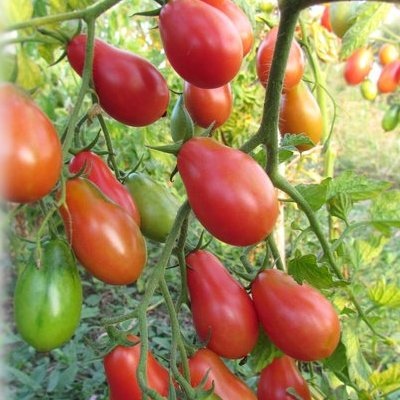
- Authors: Zink B.G., Konovalova N.V.
- Year of approval: 2007
- Category: grade
- Growth type: indeterminate
- Appointment: fresh consumption
- Ripening period: ultra early
- Ripening time, days: 80-90
- Growing conditions: for open ground
- Bush size: tall
- Foliage: medium
Among those who like to grow interesting types of vegetables on their plots, the Pink Snow tomato variety has become very popular. And it is interesting in that it surprises not only with its taste and yield, but also with its aesthetic appearance. Sweet cocktail tomatoes are collected in huge clusters, each of them can contain up to 50 fruits. It is worth learning more about this culture.
Breeding history
Pink snow is a successful Russian variety. Experienced breeders Zink BG and Konovalova NV took part in its creation. The seed-growing enterprise "Aelita-Agro" became the originator of the culture. The firm filed an application for admission to the use of the variety in 2005. And after the examination and field trials in 2008, the variety was included in the state register of the Russian Federation. Cultivation of crops in open beds in private subsidiary farms is recommended.
Description of the variety
Experienced gardeners are especially attracted by the fact that this is a variety, and not a hybrid. This means that it will be possible to independently harvest seed material. Bushes of Pink Snow are tall, the plant develops in an indeterminate manner. Differs in medium leafiness. The complex inflorescence forms many fruits, up to 40-50. The foliage is large, dark green. The peduncle is articulated.
There are many advantages of varietal tomato:
- high performance indicators;
- the plant steadfastly tolerates temperature extremes, short-term cold snap;
- stands out for its excellent stress resistance;
- excellent fruit taste.
There are some downsides, but these are mostly just the characteristics of the variety:
- it is necessary to monitor the formation of the bush, regularly cutting off stepchildren;
- the thin skin causes certain difficulties when preserving whole fruits, since sometimes it can crack (although the tomato still remains intact).
The main qualities of the fruit
Tomatoes are small, the so-called cocktail size, the average weight is 47 grams, but some grow up to 60-70 g. The shape is ovoid, smooth, without ribs. Unripe berries have a light green color, fully ripe tomatoes have a beautiful pink color. Inside each fruit there are two to three seed chambers.
Taste characteristics
Many characterize the taste qualities of the cocktail variety as excellent. The subspecies is recommended for fresh salad use, but it also occurs in canning and salting.
Ripening and fruiting
This is an ultra early tomato variety. Ripe pink bunches are expected to appear 80-90 days after sprouting from the seed.
Yield
Indicators of the yield of marketable fruits are not bad - 4.7 kg / sq. m.
The timing of planting seedlings and planting in the ground
Seeds of Pink Snow are sown for seedlings in late March. The immersion depth of the grains is small - from 1 to 1.5 cm. At the stage of the appearance of the first pair of leaves, picking occurs in separate containers. About a week or 10 days before planting in the ground, the seedlings are hardened for good acclimatization in a new place. Grown plants are planted in open ground at the age of 50 days. The condition for this will be the absence of the threat of the return of frosts.If the seedlings are planned to be planted in a heated greenhouse, this can be done in April, and if under film, then in May.

Growing tomato seedlings is an extremely important process, because it largely depends on whether the gardener will be able to harvest at all. All aspects must be taken into account, from seedbed preparation to planting in the ground.
Landing scheme
One of the working schemes for planting Pink Snow is placing bushes in a checkerboard pattern with a distance of 45 cm.

Growing and care
Subsequent care measures for growing Pink Snow will consist in feeding, watering and loosening the soil during the entire growing season.
A tall plant, hung with massive clusters with a large number of fruits, requires an obligatory garter to the support. It is recommended to form a tomato into one stem, removing stepchildren on time.
Watering is carried out with warm water, always in the evening. The procedure is carried out about 3 times a week. Then the soil is loosened while removing weeds.
Mulching the soil after watering will not only save moisture, but also minimize the number of weeds. 10 days after planting in the ground, it is worth carrying out the first feeding of tomatoes. To do this, use chicken manure dissolved in water or any complex fertilizers.




A plant needs different micronutrients at each stage of growth. All fertilizers can be divided into two groups: mineral and organic. Folk remedies are often used: iodine, yeast, bird droppings, eggshells.
It is important to observe the rate and period of feeding. This also applies to folk remedies and organic fertilizers.


Resistant to adverse weather conditions
Pink snow is a tomato variety that stands out for its special heat resistance, and also has a high level of drought resistance.
Growing regions
Almost all gardeners living in various parts of the country can grow the described varietal tomato:
- north and northwest of the European part of Russia;
- Central region, as well as the Central Black Earth Region;
- Volgo-Vyatka region;
- North Caucasus;
- Middle and Lower Volga, as well as the Ural regions.
Tomato is suitable for growing even in Siberia and the Far East.

























































































